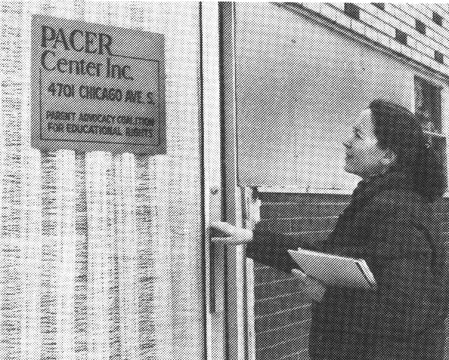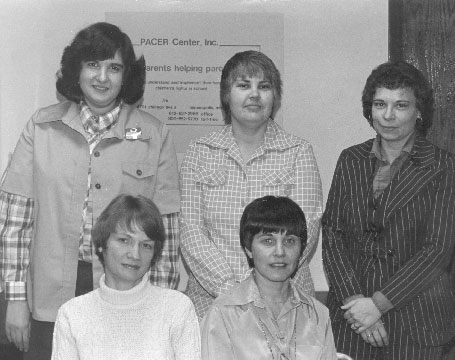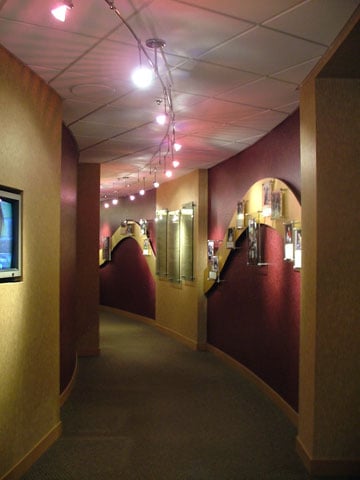History of PACER Center
When PACER was established in 1977, it began with one project: Parents Helping Parents. Then as now, PACER was staffed primarily by parents of children with disabilities dedicated to educating other parents and improving the lives of children with disabilities throughout Minnesota. With a small grant from the Minnesota Department of Education, PACER conducted a five-month pilot project and demonstrated the effectiveness of the "parents helping parents" model.
Although today PACER offers more than 30 programs for parents, students, professionals and other parent organizations, the original philosophy of "parents helping parents" remains the foundation upon which PACER has grown. Whether addressing the issues of early childhood or assisting youth in making the transition from high school to work, parents on PACER's staff share their experiences and their knowledge with others so that all Minnesota's children with disabilities may have a better future.
A look at the past 30 years shows the commitment and some of the accomplishments of PACER friends, boards and other volunteers and staff who have worked hard to make a difference in the lives of children with disabilities and their families.
| 1976 | The PACER Coalition is formed. |
| 1977 | PACER incorporates as a nonprofit 501(c)(3) organization. Bill Messinger writes bylaws and articles of incorporation. |
| 1978 | PACER opens its doors in a South Minneapolis storefront location with card tables, used office furniture from 3M, and five eager employees, most of them part-time. |
| 1979 | Establishes the COUNT ME IN Puppet program that teaches elementary and preschool children about inclusion. |
| 1982 | Sponsors the first PACER Benefit at Children’s Theatre for 75 people. Now, the PACER Benefit features world-famous performers and is the “Hottest Ticket in Town.” |
| 1983 | PACER helps to write national legislation for parent training and information centers and technical assistance. |
| 1984 | Becomes a Technical Assistance for Parents Project (TAPP) Regional Office. The program helps establish PACER as a national presence in assisting parents of children with disabilities. |
| 1985 | Helps establish transition (from high school to post-secondary education or training, employment, and the community) services within the Minnesota Department of Education. Today, Minnesota is considered a national leader in transition. |
| 1987 | Opens the Simon Technology Center assistive technology program. State-of-the art equipment and nationally respected staff provide communication and learning breakthroughs for children with disabilities every day. |
| 1994 | Burns the mortgage on 4826 Chicago Ave. So. building. |
| 1997 | Becomes National Center of the Technical Assistance ALLIANCE for Parent Centers, coordinating technical assistance among the over 100 Parent Training and Information Centers and Community Parent Resource Centers across the nation. |
| 2000 | With strong financial support from individuals, corporations, and foundations, PACER moves to a family-friendly, accessible, newly renovated building at Interstate 494 and Highway 100. |
| 2004 | PACER’s first HOT Party, organized by the Young Professional Advisory Board, receives a warm reception from party-goers. |
| 2005 | PACER goes international through a collaborative assistive technology project in India. Sets of COUNT ME IN puppets take up residence with organizations in England and Japan. PACESETTER newsletter circulation hits 100,000. |
| 2006 | PACER launches PACERKidsAgainstBullying.org, an interactive Web site to help children deal with and prevent bullying. PACER has two national “firsts”: the first National Bullying Prevention Awareness Week and the first National Ted and Dr. Roberta Mann Foundation Symposium about Children & Young Adults with Mental Health and Learning Disabilities. PACER receives a five-year, almost $3 million grant from the U.S. Department of Education to be the Minnesota Parent Information and Resource Center (PIRC) for parent-school partnerships. |
| 2007 | PACER meets the strict eligibility of the Combined Federal Campaign, the largest workplace charity campaign in the country, and is added to its charity list. PACER relaunches PACER.org with a new look, new navigation, and additional high-quality content for parents and professionals. |
| 2008 | PACER spearheads collaborative effort with IBM, others to open first technology center for children and adults with disabilities in Bangalore, India. IBM Foundation gives PACER a national grant to distribute 600 Young Explorer computers and provide training to early childhood classrooms across the country. |
| 2009 | Disney teen star Demi Lovato helps PACER launch its new PACERTeensAgainstBullying.org, an innovative Web site to help teens deal with and prevent bullying. PACER joins the social media world by adding its own Facebook and Twitter accounts, after launching a YouTube Channel in 2008. |
| 2010 | PACER’s National Bullying Prevention Awareness Week becomes National Bullying Prevention Month and soon garners nationwide publicity from major media including CNN, Family Circle, Woman’s Day, People, Ellen DeGeneres’ website, CBS Today Show, and NBC with Brian Williams. A new Kids Against Bullying puppet program is created, while the COUNT ME IN program continues to spread across the globe with a puppet training conducted in Trinidad. A record 1,100 parents and teachers attend the Fifth Annual Ted & Roberta Mann National Symposium About Children and Young Adults with Mental Health and Learning Disabilities, which is co-sponsored by PACER. |
| 2011 | PACER’s Executive Director and PACER advocates are invited to the White House Conference on Bullying Prevention. PACER’s Executive Director is invited to testify at Office for Civil Rights on behalf of students with disabilities and bullying. |
| 2012 | The FBI Director awards PACER's National Bullying Prevention Center with the Director's Community Leadership Award. PACER’s Simon Technology Center celebrates 25 years of service. PACER receives a five-year grant from the federal Office of Special Education Programs called Technology to Improve Kids’ Educational Success (TIKES). TIKES will train educators to help young children use assistive technology in the most effective ways possible. The grant to PACER was one of only three such projects in the country. |
| 2015 | Opened a Los Angeles office for PACER’s National Bullying Prevention Center. |
| 2016 | PACER launches Tech for Teens project, a series of workshops for middle and high school students with disabilities to increase interest and exposure to 21st century job skills such as coding, programming, and robotics. |
| 2018 | Opened Innovation Lab, a collaborative learning space with cutting-edge technology that is accessible to students with all types of physical, sensory, and other disabilities. Held first Gala for PACER’s National Bullying Prevention Center in Los Angeles. Awarded Statewide Family Engagement Center grant from U.S. Department of Education to serve families of children with and without disabilities, one of 11 in the country. |
| 2022 | Gretchen Godfrey serves as Interim Executive Director, following death of executive director and co-founder Paula Goldberg. |
| 2023 | Tonia Teasley hired as PACER’s Executive Director, succeeding co-founder Paula Goldberg. |
A look at PACER in 1977

PACER's first office

Original five employees:
Paula Goldberg, Marci Bergdahl, Joan Schoepke, Evy Anderson, and Marge Goldberg
PACER opens it doors in a South Minneapolis storefront location with card tables, used office furniture from 3M, and five eager employees, most of them part-time.
Today, PACER is located in a family friendly, accessible building with over 60 staff members.


